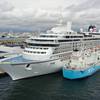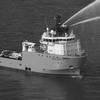The increased focused on emission of all types is hardly news to shipowners and marine propulsion suppliers. For decades, entities from individual groups to international policymakers continuously changed the manner in ships and boats are operated. But today perhaps more than ever before, scrutiny of emissions from ships and boats has never been more intense, or as critical in the development, design and marketing of marine propulsion equipment.
Diesel engine manufacturers, for example, are spending a good percentage of their sizable R&D budgets dedicated to ensuring their engines are not only compliant with ever-tightening emissions rules and regulations, but to ensure that these same "new" engines operate as reliably and efficiently under the new operating realm. The concept of emission control is hardly a new one to these same manufacturers, which have had to contend with strict rules and regulations in the other industry's -- such as automotive and industrial -- they serve.
Airing Out
Much of the emission attention is, of course, squarely focused on the realm of minimizing pollutants, particularly NOx. With the new International Maritime Organization regulations regarding NOx emissions planned to take effect January 1, 2000 (see related story, page 74), most engine manufacturers' efforts are focused on ensuring that their entire line-up falls within the prescribed emission levels, thus ensuring their customers are in compliance. However, at press time, a new report from noted international researchers was sure to give pause to all involved in the process of propelling ships, as focus has now shifted to the potential effects on sulfur emissions from ships.
Scientists at Carnegie Mellon University and Duke University said (in a letter to the science journal Nature) that ships are emitting more sulfur than previously suspected, causing ocean and coastal pollution and affecting scientific understanding of global climate change.
The concerns are varied, and include the thought that regional sulfur emissions contribute to acid rain, which can pollute bodies of water. Emissions from ships are also involved in the formation of clouds over the oceans.
"Sulfur emissions have a large role in the formation of aerosols (tiny particles) on which water condenses to form clouds," said Spyros Pandis, who contributed to the study. "The interactions of aerosols and clouds have been identified as one of the most important uncertainties in understanding the rate of climate change, or global warming, because clouds reflect energy and thereby reduce the net warming effect of long-lived greenhouse gases."
The researchers also reportedly showed that the emissions from ships were most evident in oceans in the Northern Hemisphere where heavy shipping occurs. While comments on the study from the maritime community were not forthcoming at press time, it can be sure that the topic will be a headliner discussion for many industry and legislative conferences and meetings.
Quiet, Please
While the issues of noise and vibration are generally off of the radar scope in the legislative sense -particularly in comparison to matters regarding, for example, exhaust emissions -- efforts to reduce noise and vibration levels have been ongoing for many years. Germany was one of the first countries to introduce a standard for noise limits when in 1968 it issued a code regarding permissible noise levels on ships. Today, there is a plethora of international and national codes that both recommend and demand maximum permissible noise levels aboard ships.
Additionally, scientific evidence regarding the effects of noise on everything from shipboard personnel to whales is sure to raise the bar in regards to noise control in years to come. Simple in statement, yet
complex in real-world delivery, continuing efforts to reduce emissions, noise and vibration signatures aboard vessels of all types and sizes is a technological challenge, particularly given the acoustical properties of water and of the primary materials utilized in shipbuilding.
MAN B&W has continued to lead the charge on many diesel engine R&D fronts, and has published a report entitled "Diesel Engines and the Environment - Noise." The company's efforts in the field of environmental issues are numerous, and it has earned it the Danish Environmental Prize for developing plant for removing nitric oxides from exhaust gases. The company notes that whereas noise was traditionally considered a "necessary evil," today excessive noise is considered a form of pollution with far reaching ramifications. In general, the brochure notes that noise emitted by the engine's exhaust gas, and the structure borne noise excited by the engine, are so low that it is possible to keep within the noise requirements for the bridge wing and accommodation. On the other hand, airborne noise emitted from the engine in the engine room is so high that in some cases there is a risk that the noise limits for the engine room cannot be met, unless additional noise measures are introduced. Hence, the company sees future efforts pointed toward developing an engine with reduced airborne sound levels.
Sponsored Content
Safer Starts Here: Build Ships, Protect Crews

Subscribe for
Maritime Reporter E-News
Maritime Reporter E-News is the maritime industry's largest circulation and most authoritative ENews Service, delivered to your Email five times per week











